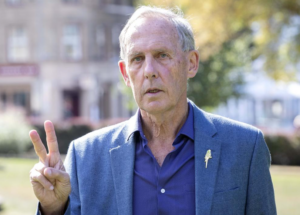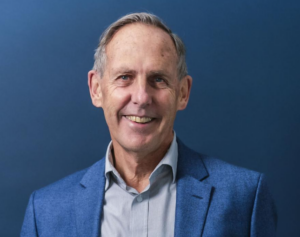#Bob #Brown #ABC #News #Family #Facts
Welcome guys to All Social Updates. Here you can Find complete information about all the latest and important updates about every matter from all around the world. We cover News from every niche whether its big or small. You can subscribe and bookmark our website and social media handles to get the important news fastest before anyone.Follow our website allsocialupdates.com on Facebook, Instagram , Twitter for genuine and real news.

Where is Bob Brown of ABC News now?
In 1997, Bob Brown began working for ABC News as a correspondent in New York. He might still be working at ABC News today.
He worked as an anchor for KHOU-TV in Houston for two years prior to his employment in Dallas. Before joining the army for two years, he worked for KOTV in Tulsa for two terms.
He got his degree from the University of Tulsa and then taught people how to write news stories. He gives talks at the Graduate School of Journalism at Columbia University and the Park Distinguished Visitor Series at Ithaca College.
He wrote China and World and United States History, Volume Five, which is used in high schools.
He wrote about the life of Irish tenor Dr. Ronan Tynan, who earned his medical degree from Dublin’s Trinity University and went on to win Special Olympics gold medals around the world.
Before joining 20/20 full-time, Brown wrote “Special Assignment” stories for ABC News’ World News Tonight in 1979 and 1980. These stories were about the Irish Republican Army and the 10th anniversary of the Woodstock Music Festival.
He also worked for ABC News when the 1980 Winter Olympics were held in Lake Placid, New York.
Find Out Who Is Bob Brown’s Wife
Bob Brown has not said publicly whether or not he is married. It is not clear if he is married or not.
But based on his age, he seems to be married and living alone. Brown may not want people to know about his personal life, so he keeps his information hidden.
He also doesn’t use his social media page, so we don’t have much to learn about Bob’s personal life.
Bob Brown’s work
Bob Brown is a reporter for ABC News, and he writes about a lot of different things for the show.
He also took part in the popular ABCNEWS Millennium program, which was always on. He tells the story of how a medical mission in the Dominican Republic changes the lives of two extraordinary missionaries and a charming boy who needs their help.
He also tells an inspiring story about a door-to-door salesman from Portland who has cerebral palsy but has been walking his route for 35 years.
Brown also tells the story of a 35-year-old mother who wrote a book about her daughter while she was battling cancer.
Also, he frequently narrates programs on the Discovery Channel and the A&E show Biography.
In 1991, the American Women in Radio and Television gave her an award for playing a strong and ambitious woman.
The President’s Committee on Employment of People with Disabilities gave him a media award for his profile of Christopher Nolan.
She was given a Media Access Award by the California Governor’s Committee for Employment of the Handicapped for the stories she wrote.
How I grew up and went to school
Brown was born in Oberon, New South Wales, one of twins. He attended Trunkey Public School, Coffs Harbor High School (1957–60), and Blacktown Boys High School. In his last year of high school, he was chosen as the school captain.
Brown went to the University of Sydney to study medicine after he finished high school. There, he earned a Bachelor of Medicine and Surgery degree.
Brown was inspired by Robert Menzies, who was Prime Minister at the time, when he was in his early 20s. He almost joined the Liberal Party of Australia.
Before running to the office
Brown was a doctor at the Royal Canberra Hospital for a while. During his time at the hospital, he and other senior medical staff took a pacifist stance by not identifying as young men who did not want to fight in the Vietnam War. Afterwards, he worked as a resident in hospitals in Darwin and Alice Springs. At the second job, he met Dr. John Hawkins, who kayaked the rivers in Tasmania.
Brown went to London in 1970 and worked at Hounslow Cottage Hospital and St. Mary Abbots Hospital in South Kensington.
[8] When Jimi Hendrix was brought to St. Mary Abbots Hospital, he was the doctor on duty.
At the time he retired, many news outlets claimed, incorrectly, that he had said Hendrix was dead. Brown later said that although he was on duty when Hendrix was brought in, “he had been dead for some time,” and that Hendrix was officially pronounced dead by another doctor, also an Australian.
Brown moved to Tasmania in 1972. In Launceston, he worked as a general practitioner. He soon joined the environmental movement in the state, especially the effort to save Lake Pedder. In 1972, he joined the United Tasmania Group, which was Australia’s first “green” party. In the 1970s, Brown was part of a team that searched for Thylacines for two years.
In 1976, he went to the top of Mt. Wellington and fasted for a week to protest the arrival of the nuclear-powered warship USS Enterprise in Hobart.
state government
In the 1990s, Brown was elected to the Senate.
Brown was put in charge of the Tasmanian Wilderness Society in 1978. In the late 1970s, he became a leader in the fight against the construction of the Franklin Dam, which would have flooded the Franklin River valley as part of a hydroelectricity project. Brown was one of 1,500 people arrested during the protest campaign. After this, he was placed in Hobart’s Risdon Prison for 19 days. On the day he was released from prison in 1983, he became a member of Tasmania’s parliament for the House of Assembly seat of Denison. This was after Democrat MP Norm Sanders resigned to run for the Australian Senate and won. Brown was elected to replace Sanders in a countback. After the Federal government stepped in to protect the Franklin River in 1983, Franklin’s campaign was successful.
In his first term in office, Brown introduced a wide range of private member’s initiatives, such as freedom of information, death with dignity, lowering parliamentary salaries, gay law reform, industrial bans of batteries, and advocating for a nuclear-free Tasmania. . Liberal and Labor members of Tasmania’s House of Assembly voted against his bill to ban semi-automatic firearms in 1987. This was nine years before the Port Arthur massacre, which led the federal Liberals to win their bid to do the same thing.
Tasmania’s proportional representation system allowed the Greens to win five of the 35 seats in the state’s House of Assembly in 1989, with Brown as their leader.
He agreed to support a minority Labor government based on an Agreement (signed by Michael Field and Bob Brown) in which the independent Greens agreed to support the budget but not motions of no confidence and the ALP agreed to develop a more open parliamentary process, to consult on departmental appointments, to provide a legislative research service, equality in parliamentary staff, and a reform agenda that included of equal opportunity and freedom of information.
This deal collapsed in 1992, however, due to forest disputes. In 1993, Brown left the House of Assembly and tried to run for the federal House of Representatives, but he did not win.
Brown pushed for the Green Independents and the Australian Democrats to merge to form the “Green Democrats” instead of joining with other Green Parties to form the Australian Greens. But when the Democrats changed who was in charge, this plan could not continue, and the Independents moved towards a Green Party.


Politics at the federal level
Brown at Tasmania’s Salamanca Market in December 2004
Brown talks about how the Greens plan to tackle climate change ahead of the 2007 federal election.
Brown at a rally in Melbourne on July 5, 2008, about climate change.
Adam Bandt, Brian Walters, and Brown ran for state office in Victoria, Australia, in 2010.
Greg Barber, Brian Walters, and Brown go to a protest rally in Melbourne in 2010.
Brown was elected to the Australian Senate for Tasmania in 1996. He was an outspoken critic of John Howard’s conservative government and a supporter of green and human rights issues, including Tibet, East Timor, and West Papua, which all are in other countries. He also introduced bills to amend the Constitution, protect forests, stop the dumping of radioactive waste, stop the forced sentencing of Aboriginal children, stop the use of cluster munitions, and eliminate greenhouse gases.
In the 2001 federal election, Brown won more votes and was re-elected to the Senate. He spoke out against Prime Minister John Howard’s decision not to let 438 asylum seekers (mostly from Afghanistan) land on Christmas Island after the MV Tampa, a Norwegian freighter, rescued them from their sinking boat in the Indian Ocean . Brown was also unhappy with the way Kim Beazley agreed with John Howard’s position on the Tampa incident.
Brown spoke out strongly against Australia’s involvement in the invasion of Iraq in 2003. He became known as a leading voice in the anti-war and pro-peace movement. When President Bush came to Canberra on October 23, 2003, Brown and fellow senator Kerry Nettle addressed both houses of parliament in a joint session. During Bush’s speech, Brown and Nettle carried signs about David Hicks and Mamdouh Habib, two Australians who were held in Guantánamo Bay, Cuba, at the time. Habib was later released without charges, but Hicks went to prison for providing material support to terrorism. Bush laughed off the interruptions, but Neil Andrew, the Speaker of the House, called out Brown and Nettle by name. This meant they were both kicked out of Parliament within 24 hours. This meant they could not go the next day when Chinese President Hu Jintao gave a similar speech. Brown shook Bush’s hand after the speech.
Brown was against the changes made by the Howard Government to the Marriage Act in 2004. He said, “Mr. Howard should relax and accept gay marriage as part of the social fabric of the future.”
